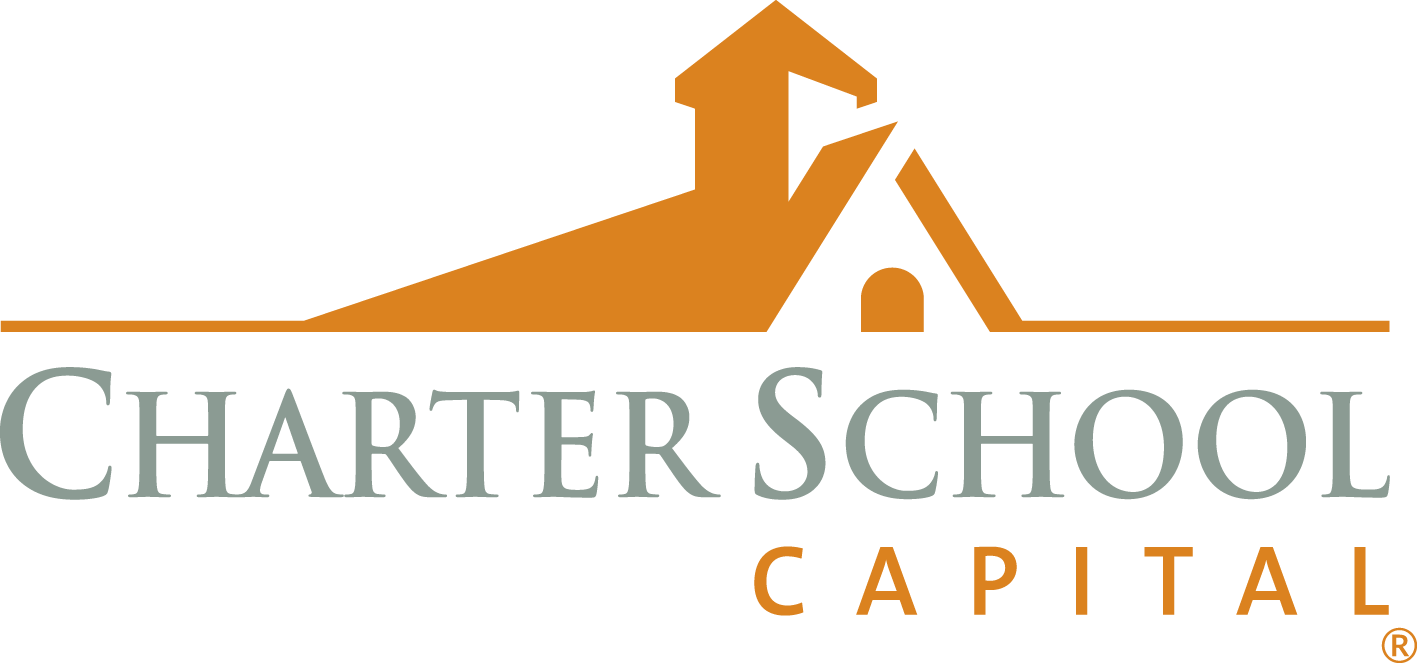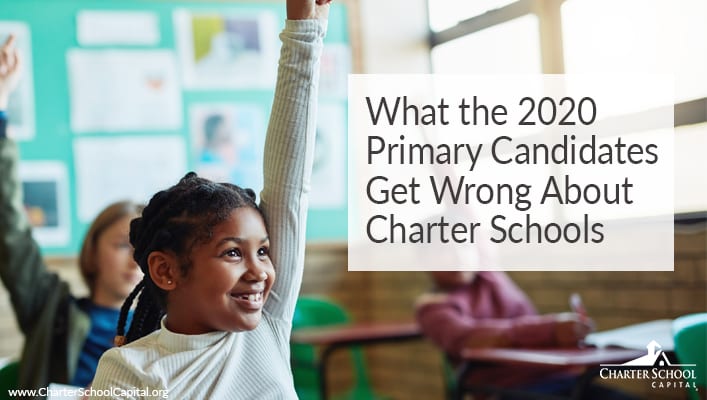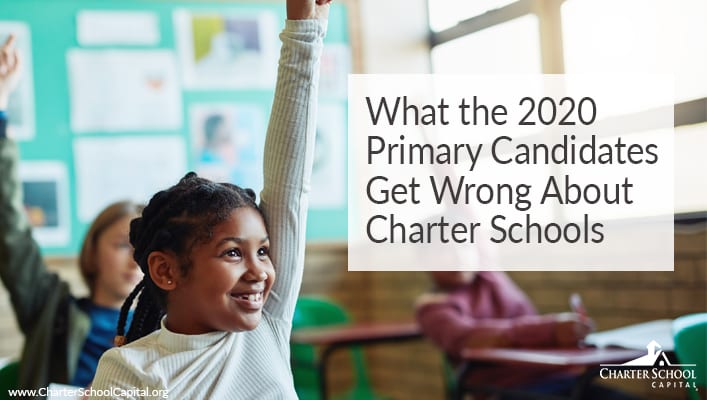What the 2020 Primary Candidates Get Wrong About Charter Schools
Editor’s Note: This article was originally published here on November 19, 2019, by the Wall Street Journal. It was written by David Osborne who leads the education work of the Progressive Policy Institute.
We think it’s vital to keep tabs on the pulse of all things related to charter schools, including informational resources, and how to support school choice, charter school growth, and the advancement of the charter school movement as a whole. We hope you find this—and any other article we curate—both interesting and valuable.
The Big Lie About Charter Schools
When Sen. Elizabeth Warren released her education plan, she trotted out a familiar charge against charter schools: that they “strain the resources of school districts.” To fight this supposed scourge, she promised to end federal financial support for new charter schools. And she’s not an outlier among the Democratic presidential hopefuls. Her fellow progressive Sen. Bernie Sanders had already charged, in his education plan, that charter schools’ “growth has drained funding from the public school system.” Even Joe Biden —who served under President Obama, an enthusiastic charter supporter—has picked up the refrain. “The bottom line” on chartering, he told an American Federation of Teachers town hall, “is, it siphons off money for our public schools, which are already in enough trouble.”
To begin with, charters themselves are public schools. The only difference is that they are operated independently of district bureaucracies, with more freedom to design their programs and choose their teachers but also more accountability. If charters fail—if their students fall too far behind—they are usually closed.
The same arguments made about charter school funding don’t make sense in other contexts. When a family moves out of a district, the district loses state and federal money for its child’s education, but no one accuses the family of draining funds from the district. When parents move their child to a private school, no one accuses them of sabotaging public schools.
So why are leading Democratic presidential primary candidates lambasting charters as a threat to public education? Because no interest group has more clout in the Democratic primaries than teachers unions. In the last presidential election, the AFT and National Education Association combined spent $64 million.
Whether charters drain money from public school districts depends on the state. In over half the states with charters, when students decamp some or all districts get to keep their local tax revenue but no longer have to educate the children, so they actually increase their spending per pupil. In Massachusetts and New York (outside New York City), the state cushions any revenue loss. By law, Massachusetts districts should be reimbursed 100% of the state money for the student for a year, then 25% for the next five years—though the state has only met about 60% of that funding since 2015.
The unions and their allies ignore these realities and focus on costs the districts can’t cut even as they lose students: pensions, principals’ salaries, building maintenance and utilities. These costs are real, but in a majority of charter states local revenue or the state-provided cushion covers most or all of them.
And the pension problem is exaggerated. As districts lose students, they reduce their number of teachers, which also reduces payments to the pension fund. If the pension system has been properly funded, there’s no negative impact. The real problem is that most states have fallen behind on their funding obligations, and now some districts are being forced, as in California, to play catch-up.
Mitigating the cost of building maintenance and utilities takes a little creative thinking. Districts can rent empty classrooms to preschool and adult-education providers. Once their schools are down to 75% capacity or below, they can lease the extra space to charter or private schools. In cities that aren’t afraid of charters, such as Washington and Denver, many school buildings house both a charter and a district school. When that’s not enough, districts can close buildings that are more than half empty and lease or sell them to charter schools.
None of this decreases the public education available to students, and it often improves the quality. But leaders of the teachers unions scream when school boards contemplate any of it.
That’s because unions shrink as charters grow. Charter schools are free to unionize, but as of last year only about 11% chose to do so. That doesn’t threaten teachers, who have more potential employers as the charter sector grows, more opportunity to choose a school that fits. But it does threaten the handsome pay union leaders receive—more than $400,000 a year for leaders of the NEA and AFT as well as more than $200,000 for other staff members.
Charter schools give millions of children—two-thirds of them nonwhite—the opportunity to get an education, go to college and move up the socioeconomic ladder. Even the unions’ favorite source of charter studies—they keep calling back to an outdated report of theirs—Stanford University’s Center for Research on Education Outcomes, has found that by their fourth year in a charter, students learn about 2.5 months more in reading every year and around two more in math than demographically similar students with the same past test scores who stayed in local district schools. In urban districts, by their fourth year students are gaining a little under half a year in reading and a little over in math—every year—over their district peers.
Graduation rates, college-going rates and college completion rates are also higher among students who enroll in charter schools. And as a handful of studies have shown, competition from charters can push district and school leaders to improve their schools, to make them more attractive to parents.
Presidential candidates should worry about how to get Americans the most bang for our education buck. The data show that the answer is to grow the best charters, as Sen. Cory Booker proudly did when he was mayor of Newark, N.J.—something he had the courage to say when debate moderators asked him the charter question. In Wednesday’s debate, other candidates should follow his example.
Mr. Osborne, whose latest book is “Reinventing America’s Schools: Creating a 21st Century Education System,” leads the education work of the Progressive Policy Institute.
Correction
New York state cushions the revenue loss when students transfer to charter schools only for school districts outside New York City, and Illinois has not done so since 2009. An earlier version misstated this.
 Since the company’s inception in 2007, Charter School Capital has been committed to the success of charter schools. We help schools access, leverage, and sustain the resources charter schools need to thrive, allowing them to focus on what matters most – educating students. Our depth of experience working with charter school leaders and our knowledge of how to address charter school financial and operational needs have allowed us to provide over $2 billion in support of 600 charter schools that have educated over 1,027,000 students across the country. For more information on how we can support your charter school, contact us. We’d love to work with you!
Since the company’s inception in 2007, Charter School Capital has been committed to the success of charter schools. We help schools access, leverage, and sustain the resources charter schools need to thrive, allowing them to focus on what matters most – educating students. Our depth of experience working with charter school leaders and our knowledge of how to address charter school financial and operational needs have allowed us to provide over $2 billion in support of 600 charter schools that have educated over 1,027,000 students across the country. For more information on how we can support your charter school, contact us. We’d love to work with you!

